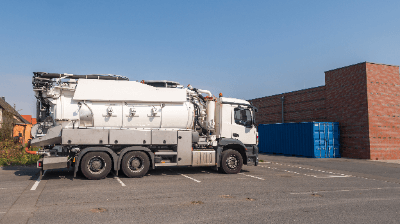All Categories
History



This section provides an overview for vacuum trucks as well as their applications and principles. Also, please take a look at the list of 5 vacuum truck manufacturers and their company rankings. Here are the top-ranked vacuum truck companies as of December, 2025: 1.Alamo Group Inc., 2.Vac-Con, 3.KOKS United States Corporation.
Table of Contents

A Vacuum Truck is a cargo vehicle equipped with a tank and suction apparatus.
Considered a special-purpose vehicle, it is officially referred to as a suction vehicle. Additionally, the term "Vacuum Truck" is a Japanese-English hybrid, and it is also known as a sanitation vehicle, sewage collection vehicle, excrement collection vehicle, or suction truck.
Typically, a Vacuum Truck is used in areas without established sewage systems for tasks such as collecting excrement or cleaning septic tanks. It is employed to collect waste from toilets like portable toilets or trains, as well as sludge stored in septic tanks. During collection operations, intermediary tanks are set up within the region, and the final processing of collected waste, such as excrement, takes place at sanitation facilities.
The primary uses of a Vacuum Truck include the collection of human waste and cleaning septic tanks. The rear of the vehicle is marked with labels like "Cargo: Excrement," emphasizing its function. The tank portion is susceptible to corrosion due to the nature of the materials it handles, resulting in a shorter lifespan compared to conventional trucks.
With the advancement of public sewage systems, the usage of Vacuum Trucks has decreased in urban areas. However, there is still a consistent demand for these trucks in construction sites, disaster evacuation areas, event locations, and facilities with temporary toilets.
The operation of a Vacuum Truck involves creating a negative pressure within the tank, similar to a vacuum cleaner, generating a pressure difference between the tank and the atmosphere. Initially named "vacuum cars" due to this mechanism, it has since evolved into the current name, a Japanese-English term.
The piping of the vacuum pump is connected to the upper part of the tank, intending to suction only the air inside the tank. The suction hose, which collects the load, is attached to the lower part of the tank. When the vacuum pump sucks the air inside the tank, the pressure inside the tank drops. Opening the valve on the suction hose causes liquids to be drawn from the hose's end. Since the hose's pressure decreases during use, a structure resistant to collapsing under external pressure is necessary.
As the liquid does not pass through the pump, valves, or hoses, it does not damage the pump during the process. By reversing the pump or switching the piping, air can be introduced into the tank, facilitating the discharge of the load. Sludge suction trucks, loaded with industrial wastewater or sludge water, feature a large opening at the rear of the tank, allowing the load to be discharged without using hoses.
For Vacuum Trucks used for human waste, deodorizers are equipped to address odor issues. Foul odors expelled from the tank are passed through deodorizing devices, reducing the lingering odor through deodorizing liquids or combustion effects, making them less noticeable even during the suction process.
A typical Vacuum Truck comprises a vacuum pump, primary manhole, suction-discharge switching lever, and deodorizing-disinfecting unit.
The vacuum pump depressurizes the tank inside the Vacuum Truck, creating a vacuum and earning its name.
The main manhole is located on the top of the tank. The parts used for attaching the manhole are positioned higher than the tank, preventing backflow. The main manhole makes internal cleaning and maintenance of the tank straightforward.
After collection, the Vacuum Truck disposes of human waste at a processing facility. The suction-discharge lever is located at the rear of the tank. When switched to discharge, the vacuum pump reverses, increasing the tank's internal pressure, and expelling the human waste.
Vacuum Trucks often require deodorizers or disinfecting units. Without proper measures, the operation of a Vacuum Truck can release unpleasant odors into the surroundings. Various deodorizing and disinfecting mechanisms are employed. Combustion-type units burn off odors through the device, releasing deodorized air outside the tank. Other methods include mixing deodorant agents or deodorizing liquids into human waste. These agents typically consist of components like sodium hypochlorite or tap water. Some use a special solution mixed with lubricating oil to transform odors into a sweet fragrance.
*Including some distributors, etc.
Sort by Features
Sort by Area

Vac-Con Inc., started in 1986 and based in Green Cove Springs, Florida, is a manufacturer of vacuum and high-pressure water cleaning solutions, and 100% belongs to employees. Its products include combination machines, jet rodders, and industrial vacuum loaders, and it has manufactured over 90,000 custom-built machines mounted on trucks. It serves public and private environmental markets worldwide and manufactures over 30,000 unique parts that it uses on its machines. It was the first company to develop the Hi-Dump dumping system, which allows operators to dump the tank into a 60-inch-tall container without leaving the site.


Ranking as of December 2025
Derivation Method| Rank | Company | Click Share |
|---|---|---|
| 1 | Alamo Group Inc. |
33.5%
|
| 2 | Vac-Con |
19.0%
|
| 3 | KOKS United States Corporation |
18.3%
|
| 4 | Guzzler Manufacturing, Inc. |
15.7%
|
| 5 | Super Products |
13.6%
|
Derivation Method
The ranking is calculated based on the click share within the vacuum truck page as of December 2025. Click share is defined as the total number of clicks for all companies during the period divided by the number of clicks for each company.Number of Employees
Newly Established Company
Company with a History
*Including some distributors, etc.
*Including some distributors, etc.
| Country | Number of Companies | Share (%) |
|---|---|---|
 United States of America
United States of America
|
2 | 100.0% |